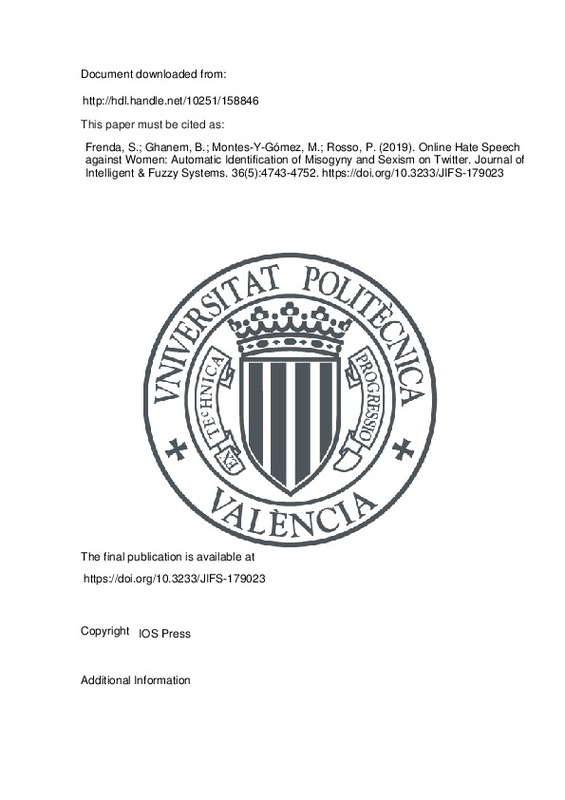Anzovino M. , Fersini E. and Rosso P. , Automatic Identification and Classification of Misogynistic Language on Twitter, Proc 23rd International Conference on Applications of Natural Language to Information Systems, NLDB-2018, Springer-Verlag, LNCS 10859, 2018, pp. 57–64.
Burnap P. and Williams M.L. , Hate speech, machine classification and statistical modelling of information flows on Twitter: Interpretation and communication for policy decision making, Internet, Policy and Politics, Oxford, UK, 2014.
Burnap, P., Rana, O. F., Avis, N., Williams, M., Housley, W., Edwards, A., … Sloan, L. (2015). Detecting tension in online communities with computational Twitter analysis. Technological Forecasting and Social Change, 95, 96-108. doi:10.1016/j.techfore.2013.04.013
[+]
Anzovino M. , Fersini E. and Rosso P. , Automatic Identification and Classification of Misogynistic Language on Twitter, Proc 23rd International Conference on Applications of Natural Language to Information Systems, NLDB-2018, Springer-Verlag, LNCS 10859, 2018, pp. 57–64.
Burnap P. and Williams M.L. , Hate speech, machine classification and statistical modelling of information flows on Twitter: Interpretation and communication for policy decision making, Internet, Policy and Politics, Oxford, UK, 2014.
Burnap, P., Rana, O. F., Avis, N., Williams, M., Housley, W., Edwards, A., … Sloan, L. (2015). Detecting tension in online communities with computational Twitter analysis. Technological Forecasting and Social Change, 95, 96-108. doi:10.1016/j.techfore.2013.04.013
Chen Y. , Zhou Y. , Zhu S. and Xu H. , Detecting offensive language in social media to protect adolescent online safety, Privacy, Security, Risk and Trust (PASSAT), 2012 International Conference on and 2012 International Conference on Social Computing (SocialCom), Amsterdam, Netherlands, IEEE, 2012, pp. 71–80.
Escalante, H. J., Villatoro-Tello, E., Garza, S. E., López-Monroy, A. P., Montes-y-Gómez, M., & Villaseñor-Pineda, L. (2017). Early detection of deception and aggressiveness using profile-based representations. Expert Systems with Applications, 89, 99-111. doi:10.1016/j.eswa.2017.07.040
Fersini E. , Anzovino M. and Rosso P. , Overview of the Task on Automatic Misogyny Identification at IBEREVAL, CEUR Workshop Proceedings 2150, Seville, Spain, 2018.
Fersini E. , Nozza D. and Rosso P. , Overview of the Evalita 2018 Task on Automatic Misogyny Identification (AMI), Proceedings of the 6th evaluation campaign of Natural Language Processing and Speech tools for Italian (EVALITA’18), Turin, Italy, 2018.
Fox, J., & Tang, W. Y. (2014). Sexism in online video games: The role of conformity to masculine norms and social dominance orientation. Computers in Human Behavior, 33, 314-320. doi:10.1016/j.chb.2013.07.014
Fulper R. , Ciampaglia G.L. , Ferrara E. , Ahn Y. , Flammini A. , Menczer F. , Lewis B. and Rowe K. , Misogynistic language on Twitter and sexual violence, Proceedings of the ACM Web Science Workshop on Computational Approaches to Social Modeling (ChASM), 2014.
Gambäck B. and Sikdar U.K. , Using convolutional neural networks to classify hate-speech, Proceedings of the First Workshop on Abusive Language Online 2017.
Hewitt, S., Tiropanis, T., & Bokhove, C. (2016). The problem of identifying misogynist language on Twitter (and other online social spaces). Proceedings of the 8th ACM Conference on Web Science. doi:10.1145/2908131.2908183
Justo R. , Corcoran T. , Lukin S.M. , Walker M. and Torres M.I. , Extracting relevant knowledge for the detection of sarcasm and nastiness in the social web, Knowledge-Based Systems, 2014.
Lapidot-Lefler, N., & Barak, A. (2012). Effects of anonymity, invisibility, and lack of eye-contact on toxic online disinhibition. Computers in Human Behavior, 28(2), 434-443. doi:10.1016/j.chb.2011.10.014
Nobata C. , Tetreault J. , Thomas A. , Mehdad Y. and Chang Y. , Abusive language detection in online user content, Proceedings of the 25th International Conference on World Wide Web, Geneva, Switzerland, 2016, pp. 145–153.
Poland, B. (2016). Haters. doi:10.2307/j.ctt1fq9wdp
Samghabadi N.S. , Maharjan S. , Sprague A. , Diaz-Sprague R. and Solorio T. , Detecting nastiness in social media, Proceedings of the First Workshop on Abusive Language Online, Vancouver, Canada, 2017, pp. 63–72. Association for Computational Linguistics.
Sood, S., Antin, J., & Churchill, E. (2012). Profanity use in online communities. Proceedings of the 2012 ACM annual conference on Human Factors in Computing Systems - CHI ’12. doi:10.1145/2207676.2208610
[-]







![[Cerrado]](/themes/UPV/images/candado.png)


